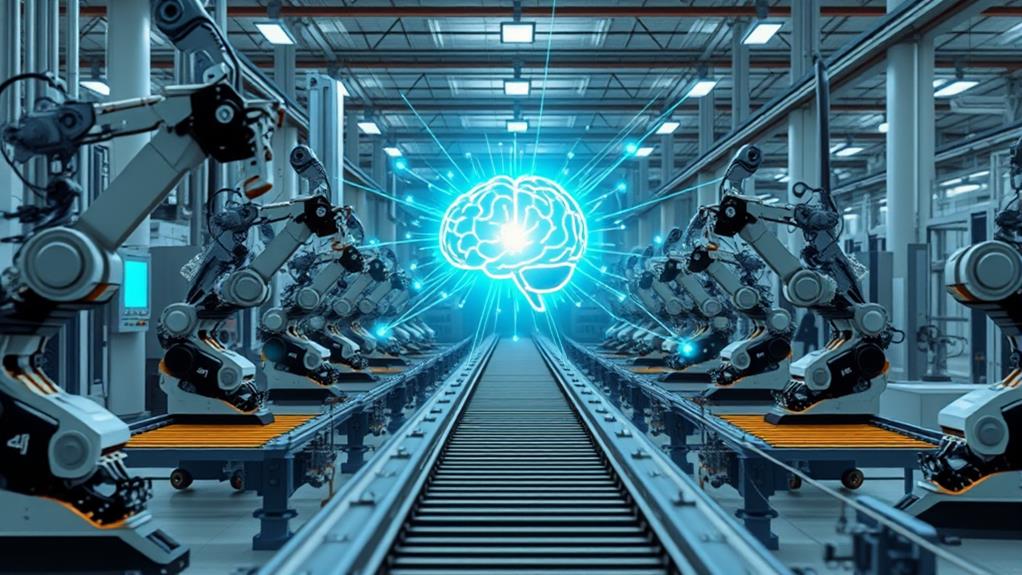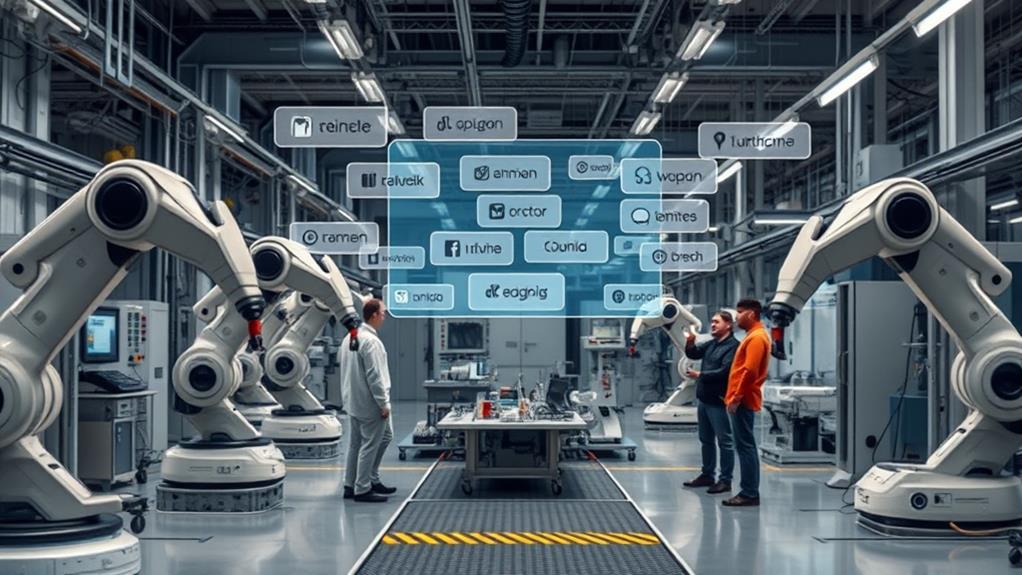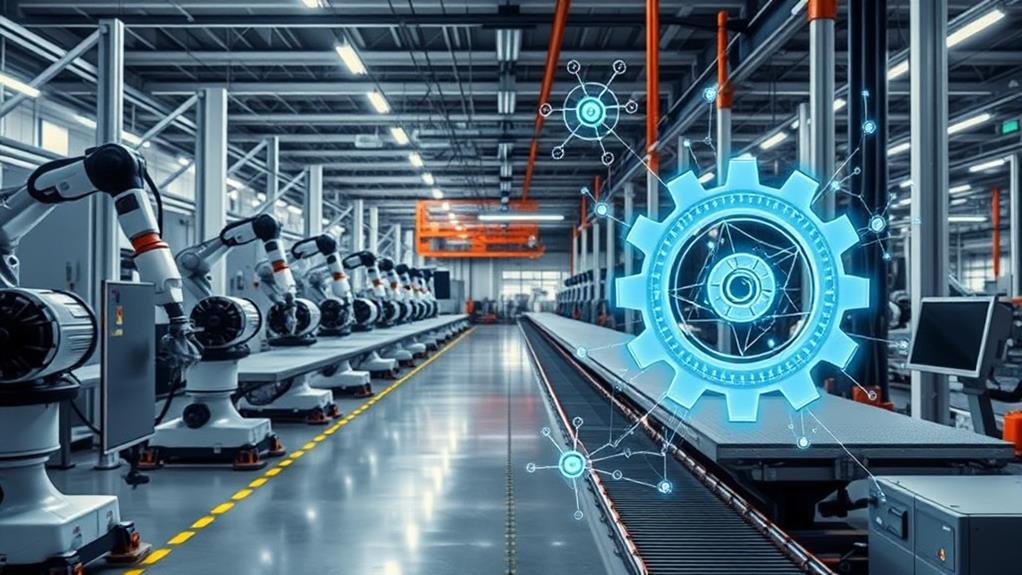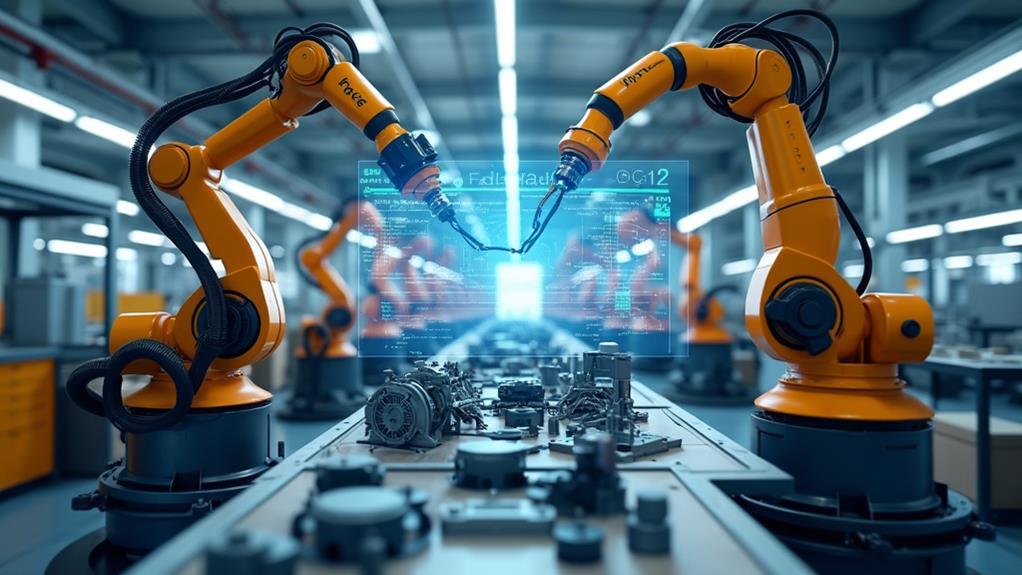Exploring NLP in industrial automation isn’t just tech talk; it’s a game-changer. Imagine boosting product quality with real-time sentiment analysis or predicting maintenance needs like a futuristic oracle—NLP does that! Supply chains get turbocharged, cutting delays by automating insights from shipping documents. And hey, multilingual teams can now chat effortlessly, thanks to seamless translations. Even employee training gets a makeover, turning snooze-worthy manuals into interactive experiences. Sure, there are challenges, like integrating with old systems or ensuring data privacy, but the rewards? Oh, they’re massive. Ready to discover how this transformation unfolds across the entire industry?
Table of Contents
Key Takeaways
- Quality Control: NLP automates text analysis for efficient quality control and detects negative trends to improve product quality.
- Supply Chain Optimization: NLP automates insights extraction from unstructured data, streamlining communication and optimizing logistics.
- Predictive Maintenance: NLP analyzes maintenance logs to identify patterns, enabling proactive repairs and reducing machinery downtime.
- Real-time Language Translation: NLP-powered tools enhance multilingual collaboration, reducing miscommunication and improving productivity.
- Employee Training and Engagement: NLP transforms training resources, provides real-time support, and gauges employee satisfaction for a dynamic workplace.
Key NLP Applications

In the domain of industrial automation, key applications of Natural Language Processing (NLP) are revolutionizing various operational aspects. Imagine a world where machines understand human language—well, we are practically living in it.
One of the groundbreaking NLP applications is in quality control. By monitoring feedback and social media in real-time, NLP guarantees consistent product quality through automated text analysis. It’s like having a vigilant digital watchdog that never sleeps.
Supply chain optimization is another area where NLP shines. By interpreting queries and automating responses, it vastly improves demand forecasting and inventory management. Think of it as having a crystal ball that tells you exactly what stock to keep, making sure you never run out or overstock.
Moreover, real-time language translation powered by NLP enhances communication efficiency among global teams. No more “lost in translation” moments—just seamless collaboration.
In the sphere of additive manufacturing, NLP streamlines 3D printing processes by analyzing design specs, minimizing errors, and boosting product quality.
Predictive Maintenance
Expanding beyond quality control and supply chain optimization, predictive maintenance stands out as another transformative application of NLP in industrial automation. Imagine a world where equipment failures are nearly nonexistent, thanks to proactive repairs! This is the reality for 47% of global manufacturers who leverage NLP to analyze maintenance logs and sensor data. By identifying patterns in vast amounts of unstructured data, like service reports and technician notes, NLP systems enable companies to anticipate issues before they become problems.
Companies like Siemens are leading the charge, integrating NLP to streamline maintenance. This not only optimizes production schedules but also greatly reduces unplanned downtime. The result? A well-oiled machine—literally and figuratively.
| Aspect | Impact of NLP in Predictive Maintenance |
|---|---|
| Unstructured Data | Efficient analysis of service reports and logs |
| Operational Efficiency | Enhanced decision support and resource allocation |
| Proactive Repairs | Minimized downtime and extended equipment lifespan |
NLP’s ability to enhance decision-making capabilities allows manufacturers to allocate resources more efficiently, translating to improved operational efficiency. So, next time you hear a factory hum smoothly, remember—it’s not just the machines but smart NLP-driven maintenance keeping things in tune.
Quality Control

Quality control in industrial automation has reached new heights with the integration of Natural Language Processing (NLP) technologies. Imagine having the ability to monitor customer feedback and social media in real-time, instantly flagging quality issues. This isn’t sci-fi—it’s today’s manufacturing reality.
NLP systems enable manufacturers to promptly identify and address these issues, ensuring consistent product standards and happier customers. By automating text analysis of production feedback, NLP ramps up the efficiency of quality control processes. It’s like having an extra pair of eyes that never sleep, allowing manufacturers to allocate resources more effectively.
Automated sentiment analysis dives deep into customer feedback, detecting negative trends before they spiral out of control. This proactive approach translates into fewer defects, better product quality, and a rock-solid brand reputation.
Let’s not forget the numbers: about 47% of global manufacturers are already on board with NLP technologies for quality control. The results? A significant reduction in defects and a boost in brand reputation.
Industrial automation paired with NLP is not just a trend; it’s a game-changer, pushing the boundaries of what’s possible in quality control.
Supply Chain Optimization
As manufacturers continue to leverage NLP for unprecedented advancements in quality control, the technology’s impact on supply chain optimization is equally transformative. NLP enhances supply chain optimization by automating the extraction of insights from unstructured data, such as shipping documents and contracts. This automation improves decision-making processes, allowing companies to act on accurate, real-time information.
Predictive analytics, powered by NLP, elevate demand forecasting, enabling more efficient inventory management and reducing holding costs. Imagine having the foresight to adjust stock levels before a product even trends—magic, right? Well, it’s NLP! By interpreting queries and automating responses, NLP streamlines communication between suppliers and manufacturers, reducing response time and enhancing collaboration.
Moreover, real-time monitoring of social media and customer feedback through NLP allows manufacturers to anticipate market demand fluctuations and adjust their supply chain strategies accordingly. This proactive approach guarantees companies stay ahead of the curve.
Additionally, NLP-driven tools can analyze maintenance logs and sensor data to provide insights that optimize logistics operations and reduce delays in the supply chain.
In essence, the seamless integration of NLP into supply chain operations not only boosts efficiency but also drives innovation, guaranteeing businesses remain competitive in an ever-evolving market.
Real-time Language Translation

Real-time language translation powered by NLP is revolutionizing the way global teams collaborate, breaking down language barriers that once hindered seamless communication.
By reducing miscommunication, these translation tools not only enhance multilingual collaboration but also minimize errors, leading to better decision-making and increased operational efficiency.
In fact, nearly half of manufacturers are already using these tools to guarantee their diverse teams can work together effectively, boosting productivity and speeding up response times.
Enhancing Multilingual Collaboration
In today’s interconnected manufacturing landscape, the ability to communicate effectively across language barriers is paramount. NLP, or Natural Language Processing, brings a transformative edge to the manufacturing sector by enabling real-time language translation.
This technological marvel enhances multilingual collaboration, allowing global manufacturers to bridge communication gaps seamlessly. Imagine teams from different corners of the world working together without the hiccups of language misunderstandings—pure productivity magic!
When language barriers vanish, decision-making processes speed up like a well-oiled machine. This is not just about getting words right; it’s about ensuring that the essence of communication is preserved, fostering better employee engagement and satisfaction.
With approximately 47% of global manufacturers already embracing NLP for this purpose, it’s clear that this is no passing trend.
Reducing Communication Errors
Effective communication is the lifeblood of industrial automation, where the stakes are high and precision is non-negotiable.
Imagine a world where global manufacturing teams can collaborate seamlessly, regardless of language barriers. That’s the magic of NLP-powered real-time translation.
When communication errors are reduced, operational performance skyrockets. In multilingual environments, these translation tools act as a bridge, allowing diverse teams to work in harmony.
The real gem here? Translating technical documents and maintenance instructions in real time. This minimizes the risk of errors during critical processes and bolsters safety protocols.
But wait, there’s more! NLP-based systems don’t just handle one language at a time; they can juggle multiple languages simultaneously. This superpower enhances team productivity and guarantees everyone is on the same page, quite literally.
Studies show that organizations equipped with real-time translation capabilities witness fewer project delays and a notable boost in overall efficiency.
Employee Training and Engagement
Transforming employee training and engagement through Natural Language Processing (NLP) can revolutionize industrial automation. Imagine trading dull manuals for interactive training resources that let employees query documents in natural language. Suddenly, finding information isn’t a chore, but a breeze. This innovation in employee training boosts onboarding processes, helping new hires adapt quickly and become productive in no time.
Virtual assistants powered by NLP can offer real-time support, making learning accessible and engaging. Picture an employee needing guidance and instantly receiving it from a virtual assistant—job satisfaction skyrockets.
Sentiment analysis takes it a step further, analyzing feedback to gauge employee satisfaction, highlighting areas for improvement, and enhancing workplace conditions.
Automation through NLP doesn’t stop there. Compliance monitoring becomes seamless, ensuring adherence to regulations and training standards. It fosters a culture of accountability and continuous improvement, essential for thriving in today’s competitive landscape.
In short, NLP’s role in transforming employee training and engagement isn’t just a luxury; it’s a necessity for any forward-thinking organization aiming to stay ahead. By embracing these innovative tools, businesses can create a more dynamic, efficient, and satisfying workplace for everyone involved.
Challenges and Opportunities

Steering the integration of NLP into industrial automation brings its fair share of headaches, particularly when wrestling with legacy systems that seem allergic to modern tech.
Tackling data privacy is like playing a high-stakes game of chess, where each move needs to be calculated to safeguard sensitive information.
But the real kicker? Bridging the skill gap with specialized training can turn these challenges into golden opportunities, paving the way for smarter, more efficient operations.
Integration Complexity Issues
Integrating Natural Language Processing (NLP) into industrial automation presents a multifaceted array of complexity issues that can greatly impact implementation. The integration complexity stems from the need to make significant technical adjustments to guarantee compatibility with legacy systems. This often requires expert assistance and can lead to increased implementation time and costs, deterring some manufacturers from adopting these cutting-edge solutions.
Moreover, a shortage of skilled personnel proficient in NLP and AI technologies can further complicate the process. This highlights the necessity for specialized training programs within manufacturing organizations. Change management strategies, including clear communication and training, are essential to mitigate employee resistance and guarantee smooth adoption of NLP technologies.
Scalability challenges also arise as manufacturers expand, necessitating NLP solutions that can handle increasing data volumes and production needs without compromising performance.
Here’s a quick snapshot:
| Challenge | Description | Impact |
|---|---|---|
| Integration Complexity | Requires technical adjustments for legacy systems | Increased time and costs |
| Skilled Personnel | Lack of NLP and AI experts | Need for specialized training |
| Scalability Challenges | Adapting NLP solutions to growing data volumes and production needs | Potential performance issues |
Addressing these challenges head-on can transform potential roadblocks into opportunities for innovation and growth.
Data Privacy Solutions
Guaranteeing robust data privacy in the implementation of Natural Language Processing (NLP) within industrial automation is both a challenge and an opportunity for manufacturers. With regulations like GDPR and HIPAA, compliance is non-negotiable, making data privacy a crucial concern.
NLP systems often process unstructured data, including sensitive customer feedback and operational logs, requiring robust governance frameworks and encryption protocols. The increasing data volume in manufacturing demands scalable solutions to maintain compliance without stifling innovation.
Effective governance frameworks can transform this challenge into an opportunity, revealing operational insights while protecting sensitive information. Regular audits of NLP-driven decisions and outputs are essential. They help identify potential biases and guarantee ethical data handling, thereby building trust in automated systems.
However, a lack of expertise in data privacy can derail even the most promising NLP projects. Specialized training for staff is fundamental to confirm they understand compliance requirements and data protection strategies.
While this might seem like a formidable task, it ultimately empowers teams to leverage NLP effectively and responsibly. In essence, tackling data privacy challenges head-on with innovative, scalable solutions not only confirms compliance but also paves the way for groundbreaking advancements in industrial automation.
Skill Gap Mitigation
Bridging the skill gap in Natural Language Processing (NLP) technologies within industrial automation is a critical challenge that manufacturers must address to stay competitive.
With 70% of organizations pointing to a skills shortage as a primary hurdle in deploying AI solutions, including NLP, the need for specialized training programs has never been more urgent. This gap hinders effective implementation and calls for a multi-faceted approach to upskill employees.
- Training Programs: Specialized courses can empower manufacturing staff with the knowledge needed to handle NLP technologies effectively.
- Collaborative Partnerships: Forming alliances with educational institutions can provide access to cutting-edge research and tailored training, addressing the skill gap directly.
- Mentorship Programs: Facilitating knowledge transfer through experienced colleagues can offer practical insights and boost confidence among employees.
- Upskilling Initiatives: Companies investing in these programs report a 25% productivity increase, enhancing efficiency and reducing errors.
Implementing these strategies can transform the workforce, making them adept at leveraging NLP for industrial automation. By integrating NLP tools into daily operations, employees can focus on higher-order problem-solving while relying on machines to automate repetitive tasks, such as data entry or report generation. As a result, efficiency is improved, and the workforce can allocate more time to innovation and process optimization. This shift not only reduces human error but also fosters a culture of continuous improvement and technological advancement.
Imagine a team that not only understands the technology but also innovates with it. By fostering a culture of continuous learning and collaboration, manufacturers can turn the skill gap into a powerful opportunity for growth and productivity increase.
Frequently Asked Questions
How to Use NLP in Automation?
NLP in automation can enhance text analysis, sentiment detection, predictive maintenance, process optimization, voice recognition, data extraction, anomaly detection, chatbots integration, inventory management, and workflow automation, leading to greater efficiency and innovation in industrial operations.
How Is NLP Used in Industry?
NLP is pivotal in industry for text analysis, sentiment detection, chatbot integration, predictive maintenance, document classification, language translation, data extraction, anomaly detection, process optimization, and real-time monitoring, thereby driving innovation and efficiency across various operational domains.
Which of the Following Is an Application of NLP in Industrial Settings?
In industrial settings, NLP applications include predictive maintenance for proactive repairs, quality control through real-time monitoring, supply chain optimization, anomaly detection in processes, chatbot integration for workflow optimization, and document classification for efficient employee training programs.
What Are the NLP Use Cases in Rpa?
NLP use cases in RPA include sentiment analysis for customer feedback, document processing for data extraction, chatbots integration, workflow optimization, predictive maintenance, compliance monitoring, anomaly detection, and language translation, greatly enhancing operational efficiency and innovation.
Conclusion
The integration of Natural Language Processing (NLP) into industrial automation holds immense promise, revolutionizing predictive maintenance, quality control, supply chain optimization, real-time language translation, and employee training. While challenges remain, such as data privacy and system complexity, the opportunities far outweigh the hurdles. Embracing NLP can lead to increased efficiency, cost savings, and enhanced worker engagement, marking a significant step forward in the digital transformation of industries. The future of industrial automation looks brighter with NLP at its core.






